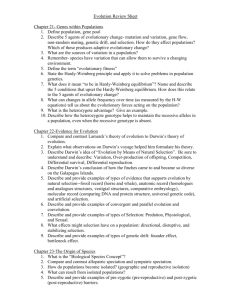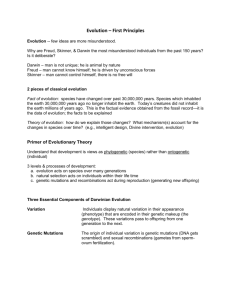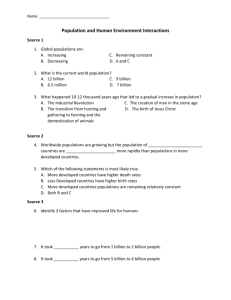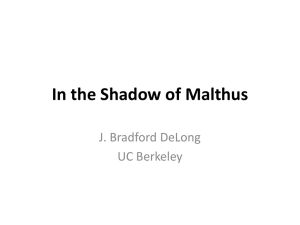Selection
advertisement
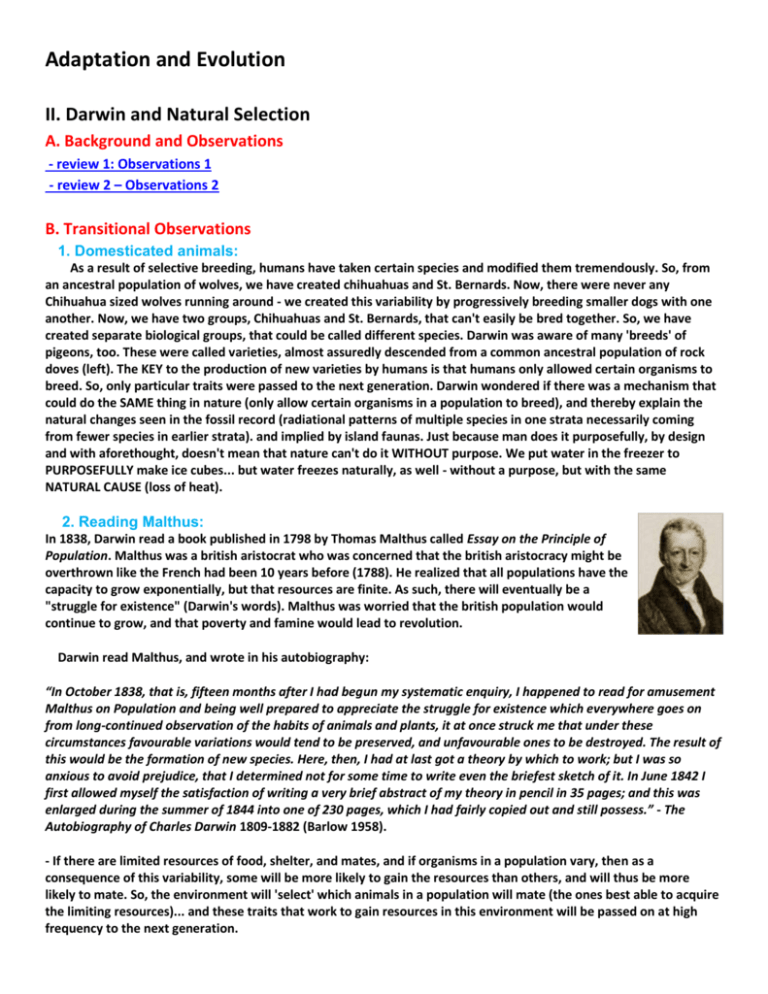
Adaptation and Evolution II. Darwin and Natural Selection A. Background and Observations - review 1: Observations 1 - review 2 – Observations 2 B. Transitional Observations 1. Domesticated animals: As a result of selective breeding, humans have taken certain species and modified them tremendously. So, from an ancestral population of wolves, we have created chihuahuas and St. Bernards. Now, there were never any Chihuahua sized wolves running around - we created this variability by progressively breeding smaller dogs with one another. Now, we have two groups, Chihuahuas and St. Bernards, that can't easily be bred together. So, we have created separate biological groups, that could be called different species. Darwin was aware of many 'breeds' of pigeons, too. These were called varieties, almost assuredly descended from a common ancestral population of rock doves (left). The KEY to the production of new varieties by humans is that humans only allowed certain organisms to breed. So, only particular traits were passed to the next generation. Darwin wondered if there was a mechanism that could do the SAME thing in nature (only allow certain organisms in a population to breed), and thereby explain the natural changes seen in the fossil record (radiational patterns of multiple species in one strata necessarily coming from fewer species in earlier strata). and implied by island faunas. Just because man does it purposefully, by design and with aforethought, doesn't mean that nature can't do it WITHOUT purpose. We put water in the freezer to PURPOSEFULLY make ice cubes... but water freezes naturally, as well - without a purpose, but with the same NATURAL CAUSE (loss of heat). 2. Reading Malthus: In 1838, Darwin read a book published in 1798 by Thomas Malthus called Essay on the Principle of Population. Malthus was a british aristocrat who was concerned that the british aristocracy might be overthrown like the French had been 10 years before (1788). He realized that all populations have the capacity to grow exponentially, but that resources are finite. As such, there will eventually be a "struggle for existence" (Darwin's words). Malthus was worried that the british population would continue to grow, and that poverty and famine would lead to revolution. Darwin read Malthus, and wrote in his autobiography: “In October 1838, that is, fifteen months after I had begun my systematic enquiry, I happened to read for amusement Malthus on Population and being well prepared to appreciate the struggle for existence which everywhere goes on from long-continued observation of the habits of animals and plants, it at once struck me that under these circumstances favourable variations would tend to be preserved, and unfavourable ones to be destroyed. The result of this would be the formation of new species. Here, then, I had at last got a theory by which to work; but I was so anxious to avoid prejudice, that I determined not for some time to write even the briefest sketch of it. In June 1842 I first allowed myself the satisfaction of writing a very brief abstract of my theory in pencil in 35 pages; and this was enlarged during the summer of 1844 into one of 230 pages, which I had fairly copied out and still possess.” - The Autobiography of Charles Darwin 1809-1882 (Barlow 1958). - If there are limited resources of food, shelter, and mates, and if organisms in a population vary, then as a consequence of this variability, some will be more likely to gain the resources than others, and will thus be more likely to mate. So, the environment will 'select' which animals in a population will mate (the ones best able to acquire the limiting resources)... and these traits that work to gain resources in this environment will be passed on at high frequency to the next generation. C. Natural Selection P1: Populations over-reproduce (Malthus) P2: resources are finite (Malthus) C1: Eventually, a population will grow until it becomes limited by its resources. At that time, their will be a "struggle for existence" and most offspring produced will die. (Malthus) P3: Individuals in a population vary, and some of this variation is heritable (Darwin - observations and animal/plant breeding) C2: Variations will not have the same probability of survival and reproduction in a particular environment; those wellsuited to the environment will be more likely to survive and reproduce than others, passing on the genes for these adapted traits. There will be "Differential Reproductive Success" (Observations, breeding). C3: Over time, adaptive traits will accumulate and the characteristics in a population will change. This is lineage evolution. (Like change in horse toes in a sequence of fossil species, or like the change in the chihuahua lineage from the ancestral wolves). Corollary: Two sub-populations, separated in different environments, would be selected for different traits and may subsequently lose the capacity to interbreed. At this point, they are different biological species. This is Speciation and Radiational Evolution. (like the production of different Finches, mockingbirds, etc. on different islands in the galapagos, and like the radiation of St. Bernards AND chihuahua's, which diverged from one another over time). III. Natural Selection - Selection is the only process that produces adaptations – characteristics that increase biological success in an environment. Because it results from the interactions between a population and the environment, adaptations and the process of selection, itself, are very important to ecology. A. The Nature of Selection 1. Types of Selection - directional: an extreme phenotype has higher fitness; mean of population moves - stabilizing: extremes are selected against; mean of population the same, variance decreases. - disruptive: both extremes selected for; mean may stay the same, variance increases. Results in polymorphic populations and potentially in sympatric speciation. 2. Modes of Selection - Natural Selection - Sexual Selection: adaptiveness of a trait depends on sex. - Kin Selection: adaptiveness depends on inclusive fitness of all organisms with that trait (relatives) - Frequency Dependent Selection: adaptiveness depends on the frequency of the trait in the population: mimicry and the ‘rare mate’ phenomenon. - Artificial Selection: purposeful selection by humans stays B. Testing for Selection and Adaptation 1. Phenotypic Plasticity: We expect selection to create differences among populations – increasing the variation between populations as each adapts to its own unique environment. However, organisms may be different from one another because they have evolved response to OTHER agents of change. In addition, a genotype may display a range of in phenotypes under a range of different environmental conditions. This range of responses exhibited by a single genotype is called a reaction norm. If these are temporary, they are acclimations. If they are permanent, they are developmental responses. 2. Differentiating between genetic “adaptations” and environmental “reaction norms” Consider plants from a single species that exhibit different phenotypes in different environments. Has this species ADAPTED differentially to these different environments, or is it basically the same genetic population that is responding differently in different environments? - Common Garden Experiment: Grow representative from different populations the same environmental conditions (environment is CONSTANT). If phenotypic differences still occur, there must be a genetic component to these differences. - Reciprocal Transplant Experiments: Expose members of each population to both environmental conditions. Now, you can actually partition the effects of environment and genotype, and also expose “genotype x environment interactions”, which (if differences correlate with fitness) represent adaptive responses by a population to a specific environment. 3. The Selective Value of Acclimation Ability: The ability to acclimate is probably costly, involving the maintenance of genetic variation (heterozygosity) to be able respond to varying environments. It is only adaptive to incur costs if the benefits outweigh them – in other words, if the will experience a range of environmental condition to which acclimation would be adaptive. In other words, populations environments should experience directional selection, and genetic ability to acclimate should be lost as genetic variation under to these organism in static the declines. STUDY QUESTIONS: 1) Outline Seelction as an argument of 3 premises, 3 conclusions, and a corollary 2) Describe and provide an example for directional, stabilizing, and disruptive selection. 3) What is a ‘reaction norm’ and how does it complicate questions of whether a phenotype is adaptive? 4) How can reciprocal transplant experiments resolve the contribution of genetic and environmental effects? How would adaptive response to different environments be expressed in this method? 5) How are genetic variations resolved using a “common garden” experiment? 6) Can the ability to acclimate, itself, be adaptive? What environments should select for this ability? How might this be genetically encoded?

